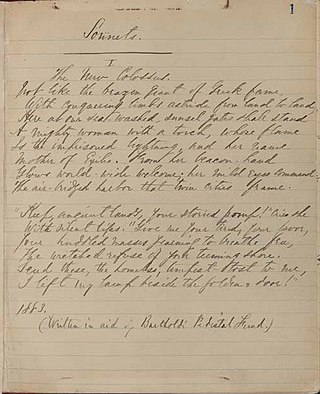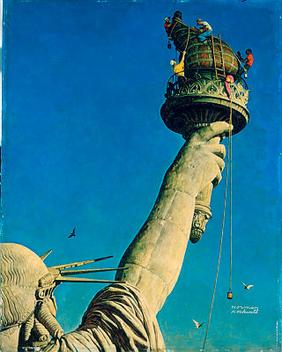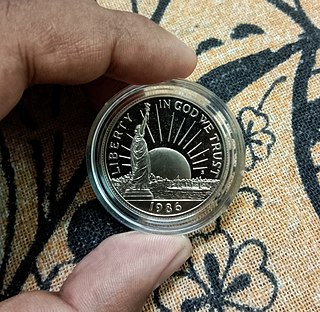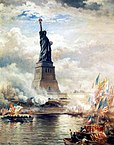
The Statue of Liberty is a colossal neoclassical sculpture on Liberty Island in New York Harbor, within New York City. The copper statue, a gift to the United States from the people of France, was designed by French sculptor Frédéric Auguste Bartholdi and its metal framework was built by Gustave Eiffel. The statue was dedicated on October 28, 1886.

Frédéric Auguste Bartholdi was a French sculptor and painter. He is best known for designing Liberty Enlightening the World, commonly known as the Statue of Liberty.

The Statue of Freedom, also known as Armed Freedom or simply Freedom, is a bronze statue designed by Thomas Crawford that, since 1863, has crowned the United States Capitol dome. Originally named Freedom Triumphant in War and Peace, a U.S. government publication now states that the statue "is officially known as the Statue of Freedom." The statue depicts a female figure bearing a military helmet and holding a sheathed sword in her right hand and a laurel wreath and shield in her left.

The concept of liberty has frequently been represented by personifications, often loosely shown as a female classical goddess. Examples include Marianne, the national personification of the French Republic and its values of Liberté, Égalité, Fraternité, and the female Liberty portrayed in artworks, on United States coins beginning in 1793, and many other depictions. These descend from images on ancient Roman coins of the Roman goddess Libertas and from various developments from the Renaissance onwards. The Dutch Maiden was among the first, re-introducing the cap of liberty on a liberty pole featured in many types of image, though not using the Phrygian cap style that became conventional. The 1886 Statue of Liberty by Frédéric Auguste Bartholdi is a well-known example in art, a gift from France to the United States.
Goddess of Liberty may refer to:

"The New Colossus" is a sonnet by American poet Emma Lazarus (1849–1887). She wrote the poem in 1883 to raise money for the construction of a pedestal for the Statue of Liberty. In 1903, the poem was cast onto a bronze plaque and mounted inside the pedestal's lower level.

Liberty Island is a federally owned island in Upper New York Bay in the United States. Its most notable feature is the Statue of Liberty, a large statue by Frédéric Auguste Bartholdi that was dedicated in 1886. The island also contains the Statue of Liberty Museum, which opened in 2019 and exhibits the statue's original torch.

Édouard René Lefèbvre de Laboulaye was a French jurist, poet, author and anti-slavery activist. Attentive observer of the political life of the United States and admirer of the American constitution, he originated the idea of a statue presented by the French people to the United States that resulted in the Statue of Liberty in New York Harbor.
Hundreds of replicas of the Statue of Liberty have been created worldwide. The original Statue of Liberty, designed by sculptor Frédéric Auguste Bartholdi, is 151 feet tall and stands on a pedestal that is 154 feet tall, making the height of the entire sculpture 305 feet.

The Princeton Battle Monument is located in Princeton, New Jersey, adjacent to Morven and Princeton's borough hall. The monument commemorates the January 3, 1777 Battle of Princeton and depicts General George Washington leading his troops to victory and the death of General Hugh Mercer. It stands 50 feet (15 m) tall and was inspired by carvings on the Arc de Triomphe in Paris. Designed to visually anchor the western end of Nassau Street, the monument and its park are a legacy of the City Beautiful movement.

Liberty Weekend was a four-day celebration held to celebrate the 1984 restoration and the centenary of the Statue of Liberty in New York City. It began on July 3, 1986 and ended on July 6.
Alex Shagin is a coin designer.
Lady Liberty may refer to:
The Ellis Island Honors Society (EIHS) is a United States 501(c)(3) organization whose mission is to honor and preserve cultural diversity and to foster tolerance, respect and understanding among ethnic groups. The EIHS was founded in 1984 as the National Ethnic Coalition of Organizations (NECO) and adopted its current name in 2017. The EIHS awards the "Ellis Island Medal of Honor" to naturalized or native-born American citizens "who preserve and celebrate the history, traditions and values of their [ethnic heritage] while exemplifying the values of the American way of life".

Gilbert du Motier, Marquis de Lafayette (1757–1834), a French aristocrat and Revolutionary War hero, was widely commemorated in the U.S. and elsewhere. Below is a list of the many homages and/or tributes named in his honor:

Working on the Statue of Liberty, also known as Statue of Liberty, is a 1946 oil painting by American illustrator Norman Rockwell, showing workmen cleaning the torch held aloft by the Statue of Liberty in New York Harbor.

Egypt Carrying the Light to Asia, also known as Progress Carrying the Light to Asia, was a plan for a colossal neoclassical sculpture. Designed in the late 1860s by French sculptor Frédéric Auguste Bartholdi, the project was to be a statue of a robed female Saeid Misr or "Upper Egyptian" bearing a torch at the entryway of the Suez Canal in Port Said, Egypt. The statue was to stand 86 feet (26 m) high and its pedestal was to rise to a height of 48 feet (15 m). The proposed statue was declined by the Khedive, citing the expensive cost, and in 1869 the Port Said Lighthouse, designed by François Coignet, was built in the same location.

Goddess of Liberty is a sculpture by Elijah E. Myers, installed atop the Texas State Capitol dome, in Austin, Texas, United States. The original statue was erected in February 1888. It was replaced by a replica on June 14, 1986, and the original was restored and relocated to the Bullock Texas State History Museum.

The Statue of Liberty commemorative coins are a series of commemorative coins which were issued by the United States Mint in 1986, the 100th anniversary of the dedication of the Statue of Liberty.














